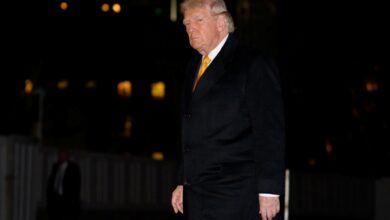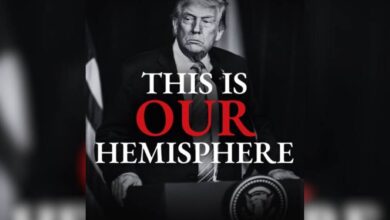5 keys to undertand the ballistic treaty between the US and Russia
The Strategic Arms Reduction Treaty (START) are agreements between the United States and Russia to reduce their nuclear capabilities and have redefined the current international system.

Starting in the 1930s and during the Cold War, the United States and the Soviet Union developed weapons of mass destruction, as did France, the United Kingdom, and China. Photo: EFE
LatinAmerican Post | Carlex Araujo
Listen to this article
Leer en español: 5 claves para entender el tratado balístico entre Estados Unidos y Rusia
Starting in the 1930s and during the Cold War, the United States and the Soviet Union developed weapons of mass destruction, as did France, the United Kingdom, and China. The two superpowers built a large nuclear arsenal and have tried to limit the possibility of an attack with bilateral treaties to restrict their number of warheads. Yet they both still account for 90% of the world's nuclear warheads. That is why we want to show you the 5 keys to the ballistic treaty between the powers:
START I
The Strategic Arms Reduction Treaty (START) I was signed on July 31, 1991 by the United States and the Soviet Union. Five months later, the Soviet Union dissolved, leaving four independent states in possession of strategic nuclear weapons: Russia, Belarus, Ukraine, and Kazakhstan. On May 23, 1992, the United States and the four nuclear-capable successor states of the Soviet Union signed the Lisbon Protocol, which made the five nations party to the agreement. START I entered into force on December 5, 1994, all parties of the treaty met the agreement's implementation deadline of December 5, 2001, according to the Portal Web Arms Control Association.
El 31 de julio de 1991, #EEUU???????? y la #URSS suscribieron el Tratado de Reducción de Armas Estratégicas (START I) y su segunda versión, el Tratado de Reducción de Armas Estratégicas (START II), fue rubricada el 8 de abril de 2010.
Compartimos análisis:
????https://t.co/tKYVgliqNX pic.twitter.com/wXDIEVIzw8— CEI Gilberto Bosques (@CGBSenado) November 9, 2019
SORT
The two countries signed a new nuclear weapons agreement (SORT) on May 24 that replaced START I and II. The Strategic Offensive Reductions Treaty (SORT), which requires the United States and Russia to reduce their deployed strategic arsenals to 1,700 – 2,200 warheads each by December 31, 2012, it effectively replaced the START II requirement that each country should not deploy more than 3,000 – 3,500 warheads by December 2007.
#UnDiaComoHoy
24/05/2002 – Los presidentes de Rusia, Vladimir Putin, y de Estados Unidos, George Bush, firman en Moscú el Tratado de Reducciones de Ofensivas Estratégicas entre ambos países (SORT por su sigla en inglés), que limita su arsenal a 2.000 ojivas nucleares operativas pic.twitter.com/a9dKZeQaUU— fernando pecorelle (@masvaletarde913) May 24, 2021
START III and NEW START
After the failure of START II, START III did not even reach the negotiation phase. It was not until 2010 that the two powers signed the New START, which reduced the maximum number of nuclear warheads allowed to 1,550. This treaty was valid for ten years, extendable to fifteen. However, during his term (2017-2021), US President Donald Trump was reluctant to renew it under the pretext that Russia had already reached the agreed limits, so extending it would only harm US arsenals, which had yet to be reduced. . In addition, Trump asked to incorporate China, but Beijing and Moscow rejected the initiative.
Also read: How to travel and work legally in the USA?
The New Strategic Arms Reduction Treaty (New START) was signed on April 8, 2010 in Prague by the United States and Russia, entering into force on February 5, 2011. The new START replaced the START I treaty of 1991, which expired in December 2009, and replaced the 2002 Strategic Offensive Reduction Treaty (SORT), which ended when the New START went into effect.
Lack of new nuclear powers
Currently, there are already several countries with nuclear weapons. In addition to the traditional United States and Russia, France, India, Pakistan, China, the United Kingdom, Israel and South Africa also have these weapons. For a nuclear treaty that guarantees world peace, it is necessary to include all these actors, especially India and Pakistan, geographic neighbors with ideological disputes.
The 2 rebels
In addition to the great nuclear powers, there are also 2 countries with the possibility of producing this type of weapon, one of which already appears to have the technology of weapons and intercontinental missiles. They are North Korea and Iran. Although communist Korea has refused to enter into negotiations with the West, the participation of its main ally, China, could force them to take part.
For its part, Iran will be able to resume nuclear agreements with the G7 now that the Biden administration has reached the White House and will be able to resume the process initiated by Barak Obama and rejected by Trump.
Ultimately, a future agreement will need to address a wide range of old and new capabilities that affect strategic calculus, including missile defense, non-strategic nuclear weapons, conventional attack systems, hypersonic missiles, cyber-nuclear threats, space assets, and novel systems.




